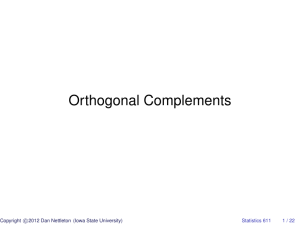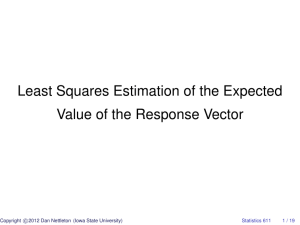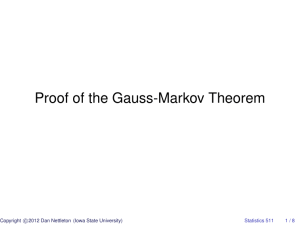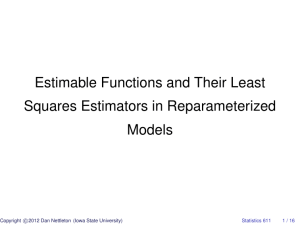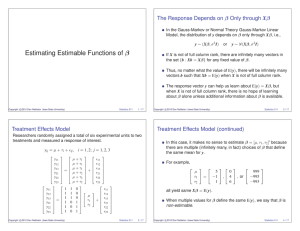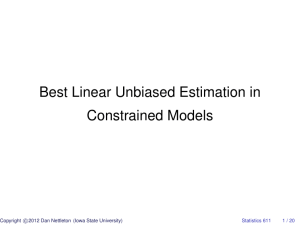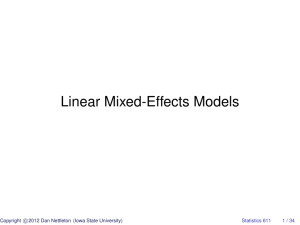Document 10639923
advertisement
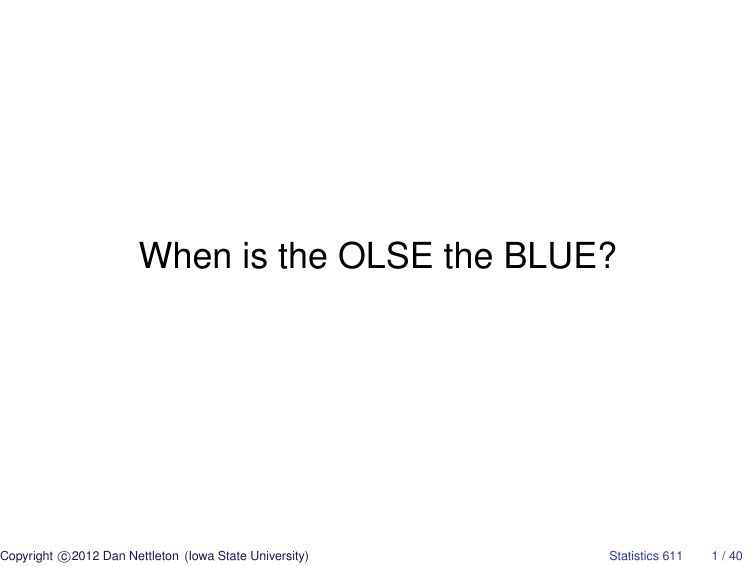
When is the OLSE the BLUE? c Copyright 2012 Dan Nettleton (Iowa State University) Statistics 611 1 / 40 When is the Ordinary Least Squares Estimator (OLSE) the Best Linear Unbiased Estimator (BLUE)? c Copyright 2012 Dan Nettleton (Iowa State University) Statistics 611 2 / 40 We already know the OLSE is the BLUE under the GMM, but are there other situations where the OLSE is the BLUE? c Copyright 2012 Dan Nettleton (Iowa State University) Statistics 611 3 / 40 Consider an experiment involving 4 plants. Two leaves are randomly selected from each plant. One leaf from each plant is randomly selected for treatment with treatment 1. The other leaf from each plant receives treatment 2. c Copyright 2012 Dan Nettleton (Iowa State University) Statistics 611 4 / 40 Let yij = the response for the treatment i leaf from plant j (i = 1, 2; j = 1, 2, 3, 4). Suppose yij = µi + pj + eij , where p1 , . . . , p4 , e11 , . . . , e24 are uncorrelated, E(pj ) = E(eij ) = 0, Var(pj ) = σp2 , Var(eij ) = σ 2 c Copyright 2012 Dan Nettleton (Iowa State University) ∀ i = 1, 2; j = 1, . . . , 4. Statistics 611 5 / 40 Suppose σp2 /σ 2 is known to be equal to 2 and y = (y11 , y21 , y12 , y22 , y13 , y23 , y14 , y24 )0 . Show that the AM holds. Find OLSE pf µ1 − µ2 and the BLUE of µ1 − µ2 . c Copyright 2012 Dan Nettleton (Iowa State University) Statistics 611 6 / 40 Although we assumed that σp2 /σ 2 = 2 in our example, that assumption was not needed to find the GLSE. c Copyright 2012 Dan Nettleton (Iowa State University) Statistics 611 23 / 40 We have looked at one specific example where the OLSE = GLSE = BLUE. What general conditions must be satisfied for this to hold? c Copyright 2012 Dan Nettleton (Iowa State University) Statistics 611 24 / 40 Result 4.3: Suppose the AM holds. The estimator t0 y is the BLUE for E(t0 y) ⇐⇒ t0 y is uncorrelated with all linear unbiased estimators of zero. c Copyright 2012 Dan Nettleton (Iowa State University) Statistics 611 25 / 40 Proof: (⇐=) Let h0 y be an arbitrary linear unbiased estimator of E(t0 y). Then E((h − t)0 y) = E(h0 y − t0 y) = E(h0 y) − E(t0 y) = 0. Thus, (h − t)0 y is linear unbiased for zero. c Copyright 2012 Dan Nettleton (Iowa State University) Statistics 611 26 / 40 It follows that Cov(t0 y, (h − t)0 y) = 0. Var(h0 y) = Var(h0 y − t0 y + t0 y) = Var((h − t)0 y) + Var(t0 y). ∴ Var(h0 y) ≥ Var(t0 y) with equality iff Var((h − t)0 y) = 0 ⇐⇒ h = t. ∴ t0 y is the BLUE of E(t0 y). c Copyright 2012 Dan Nettleton (Iowa State University) Statistics 611 27 / 40 (=⇒) Suppose h0 y is a linear unbiased estimator of zero. If h = 0, then Cov(t0 y, h0 y) = Cov(t0 y, 0) = 0. Now suppose h 6= 0. Let c = Cov(t0 y, h0 y) and d = Var(h0 y) > 0. We need to show c = 0. c Copyright 2012 Dan Nettleton (Iowa State University) Statistics 611 28 / 40 Now consider a0 y = t0 y − (c/d)h0 y. E(a0 y) = E(t0 y) − (c/d)E(h0 y) = E(t0 y). Thus, a0 y is a linear unbiased estimator of E(t0 y). c Copyright 2012 Dan Nettleton (Iowa State University) Statistics 611 29 / 40 Var(a0 y) = Var(t0 y − (c/d)h0 y) = Var(t0 y) + c2 Var(h0 y) d2 − 2Cov(t0 y, (c/d)h0 y) c2 d − 2(c/d)c d2 c2 = Var(t0 y) − . d = Var(t0 y) + c Copyright 2012 Dan Nettleton (Iowa State University) Statistics 611 30 / 40 Now Var(a0 y) = Var(t0 y) − c2 d ⇒ c = 0 ∵ t0 y has lowest variance among all linear unbiased estimator of E(t0 y). c Copyright 2012 Dan Nettleton (Iowa State University) Statistics 611 31 / 40 Corollary 4.1: Under the AM, the estimator t0 y is the BLUE of E(t0 y) ⇐⇒ Vt ∈ C(X). c Copyright 2012 Dan Nettleton (Iowa State University) Statistics 611 32 / 40 Result 4.4: Under the AM, the OLSE of c0 β is the BLUE of c0 β ∀ estimable c0 β ⇐⇒ ∃ a matrix Q 3 VX = XQ. c Copyright 2012 Dan Nettleton (Iowa State University) Statistics 611 35 / 40 Proof of Result 4.4: (⇐=) Suppose c0 β is estimable. Let t0 = c0 (X0 X)− X0 . Then VX = XQ ⇒ VX[(X0 X)− ]0 c = XQ[(X0 X)− ]0 c ⇒ Vt ∈ C(X), which by Cor. 4.1, ⇒ t0 y is BLUE of E(t0 y) ⇒ c0 β̂ OLS is BLUE of c0 β. c Copyright 2012 Dan Nettleton (Iowa State University) Statistics 611 36 / 40 (=⇒) By Corollary 4.1, c0 β̂ OLS is BLUE for any estimable c0 β. ⇒ VX[(X0 X)− ]0 c ∈ C(X) ∀ c ∈ C(X0 ) ⇒ VX[(X0 X)− ]0 X0 a ∈ C(X) ⇒ VPX a ∈ C(X) ∀ a ∈ Rn ∀ a ∈ Rn ⇒ ∃ qi 3 VPX xi = Xqi ∀ i = 1, . . . , p, where xi denotes the ith column of X. c Copyright 2012 Dan Nettleton (Iowa State University) Statistics 611 37 / 40 ⇒ VPX [x1 , . . . , xp ] = X[q1 , . . . , qp ] ⇒ VPX X = XQ, where Q = [q1 , . . . , qp ] ⇒ VX = XQ c Copyright 2012 Dan Nettleton (Iowa State University) for Q = [q1 , . . . , qp ]. Statistics 611 38 / 40 Show that ∃ Q 3 VX = XQ in our previous example. c Copyright 2012 Dan Nettleton (Iowa State University) Statistics 611 39 / 40

